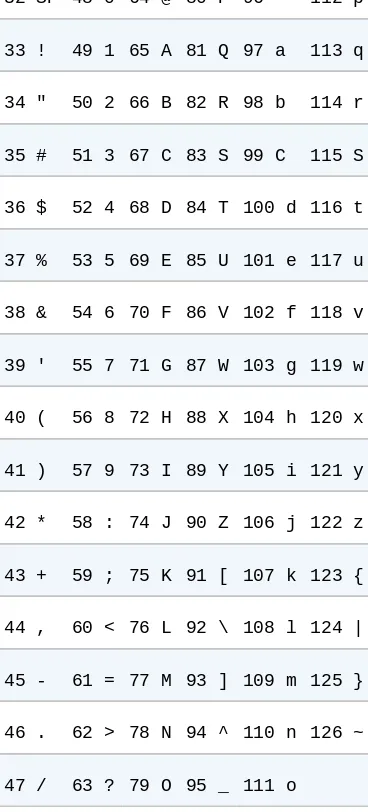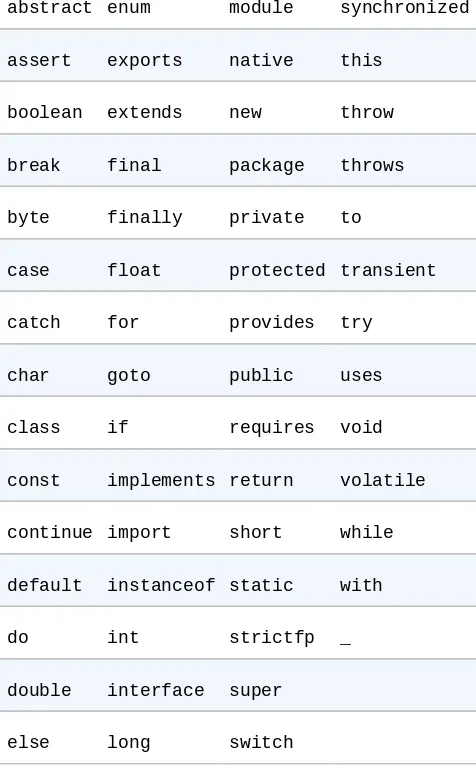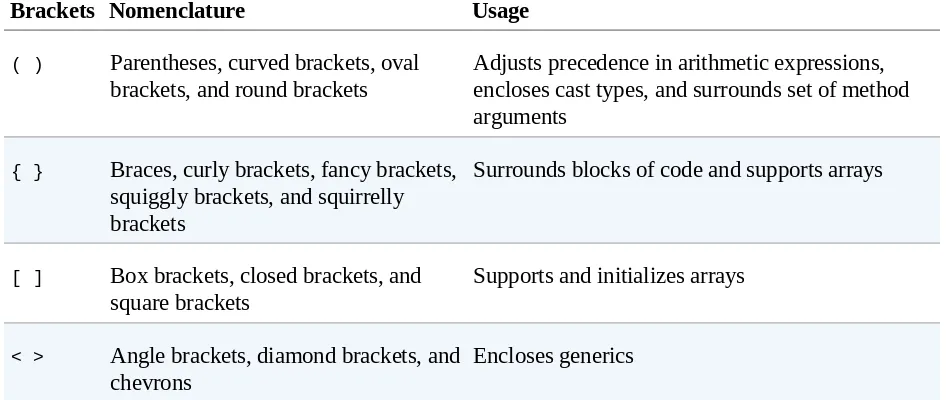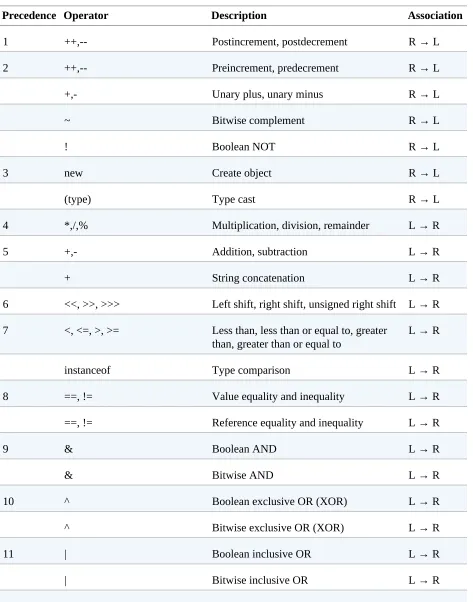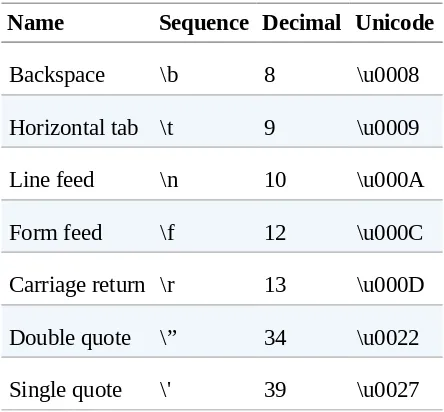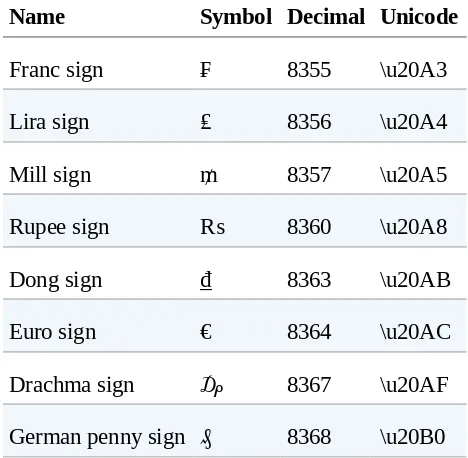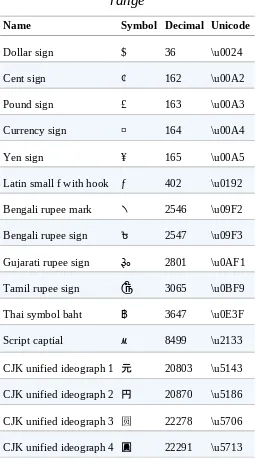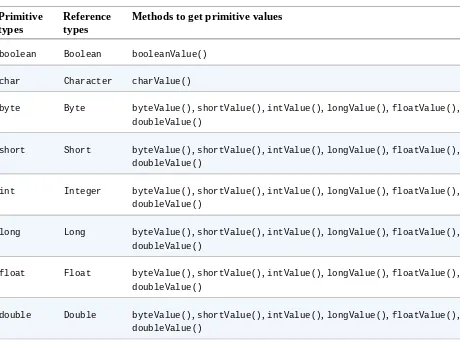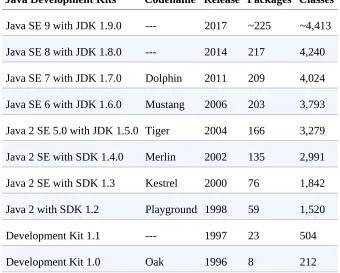Java Pocket Guide
FOURTH EDITION
Java Pocket Guide
by Robert Liguori and Patricia Liguori
Copyright ©2017 Gliesian, LLC. All rights reserved. Printed in the United States of America.
Published by O’Reilly Media, Inc., 1005 Gravenstein Highway North, Sebastopol, CA 95472.
O’Reilly books may be purchased for educational, business, or sales promotional use. Online editions are also available for most titles (http://oreilly.com/safari). For more information, contact our corporate/institutional sales department: 800-998-9938 or
[email protected]. Editor: Brian Foster
Production Editor: Justin Billing
Copyeditor: Amanda Kersey
Proofreader: Marta Justak
Indexer: Ellen Troutman-Zaig
Interior Designer: David Futato
Cover Designer: Karen Montgomery
Illustrator: Rebecca Demarest
Revision History for the Fourth Edition
2017-08-25: First Release
See http://oreilly.com/catalog/errata.csp?isbn=9781491938690 for release details.
The O’Reilly logo is a registered trademark of O’Reilly Media, Inc. Java Pocket Guide, the cover image, and related trade dress are trademarks of O’Reilly Media, Inc.
While the publisher and the authors have used good faith efforts to ensure that the information and instructions contained in this work are accurate, the publisher and the authors disclaim all responsibility for errors or omissions, including without limitation responsibility for damages resulting from the use of or reliance on this work. Use of the information and instructions contained in this work is at your own risk. If any code samples or other technology this work contains or describes is subject to open source licenses or the
intellectual property rights of others, it is your responsibility to ensure that your use thereof complies with such licenses and/or rights.
Preface
Designed to be your companion, this Pocket Guide provides a quick
reference to the standard features of the Java programming language and its platform.
This Pocket Guide provides you with the information you will need while developing or debugging your Java programs, including helpful programming examples, tables, figures, and lists.
Java coverage in this book is representative through Java SE 9 incorporating a subset of the 80+ JDK Enhancement Proposals (JEPs) slated for the release. This Java coverage includes improvements to the generage language as well as coverage of the new Java Shell and the new Java Module System. This book supercedes the three previous versions: Java Pocket Guide, Java 7 Pocket Guide, and Java 8 Pocket Guide.
For uniformity and enhanced interest, the majority of the code examples in this fourth edition of the Java Pocket Guide have been updated from code segments of the Gliesians Web Application. At the time of this writing, the primary focus of the Gliesians Web Application is to provide free utilities relative to genealogy and small unmanned aerial systems.
The material in this book also provides support in preparing for the Oracle Certified Programmer exams. If you are considering pursuing one of the Java certifications, you may also wish to acquire the OCA Java SE 8 Programmer I Study Guide (Exam 1Z0-808) by Edward Finegan and Robert Liguori
Book Structure
This book is broken into three parts: Part I details the Java programming language as derived from the Java Language Specification (JLS) and JEPs.
Conventions Used in This Book
The following typographical conventions are used in this book:
Italic
Indicates new terms, URLs, email addresses, filenames, and file extensions.
Constant width
Used for program listings, as well as within paragraphs to refer to program elements such as variable or function names, databases, data types, environment variables, statements, and keywords.
Constant width bold
Shows commands or other text that should be typed literally by the user.
Constant width italic
Shows text that should be replaced with user-supplied values or by values determined by context.
TIP
This element signifies a tip, suggestion, or general note.
O’Reilly Safari
NOTE
Safari (formerly Safari Books Online) is a membership-based training and reference platform for enterprise, government, educators, and individuals. Members have access to thousands of books, training videos, Learning Paths, interactive tutorials, and curated playlists from over 250 publishers, including O’Reilly Media, Harvard Business Review, Prentice Hall Professional,
Addison-Wesley Professional, Microsoft Press, Sams, Que, Peachpit Press, Adobe, Focal Press, Cisco Press, John Wiley & Sons, Syngress, Morgan Kaufmann, IBM Redbooks, Packt, Adobe Press, FT Press, Apress, Manning, New Riders, McGraw-Hill, Jones & Bartlett, and Course Technology, among others.
How to Contact Us
Please address comments and questions concerning this book to the publisher:
O’Reilly Media, Inc.
1005 Gravenstein Highway North
Sebastopol, CA 95472
800-998-9938 (in the United States or Canada)
707-829-0515 (international or local)
707-829-0104 (fax)
We have a web page for this book, where we list errata, examples, and any additional information. You can access this page at http://bit.ly/java-pocket-guide-4e.
To comment or ask technical questions about this book, send email to [email protected].
For more information about our books, courses, conferences, and news, see our website at http://www.oreilly.com.
Find us on Facebook: http://facebook.com/oreilly Follow us on Twitter: http://twitter.com/oreillymedia
Acknowledgments
We extend a special thank you to all the folks at O’Reilly. Appreciation of support also goes out to Greg Grockenberger and Ryan Cuprak, who wrote for the JShell and Java Module System chapters, respectively. Ryan also performed the technical review of the book, which we appreciate.
We would also like to thank again all of those who participated with the original Java Pocket Guide, the Java 7 Pocket Guide, and the Java 8 Pocket Guide.
Chapter 1. Naming Conventions
Acronyms
When using acronyms in names, only the first letter of the acronym should be uppercase and only when uppercase is appropriate:
// e.g., DNA is represented as Dna
public class GliesianDnaProvider {...}
// e.g., Most Recent Common Ancestor (MRCA) is Mrca
Annotation Names
Annotation names have been presented several ways in the Java SE API for predefined annotation types, [adjective|verb][noun]:
@Documented
@Retention(RetentionPolicy.RUNTIME)
@Target(ElementType.TYPE)
Class Names
Class names should be nouns, as they represent “things” or “objects.” They should be mixed case (camel case) with only the first letter of each word capitalized, as in the following:
Constant Names
Constant names should be all uppercase letters, and multiple words should be separated by underscores:
private static final double KELVIN = 273.16;
private static final double DRY_AIR_GAS_CONSTANT = 287.058;
Enumeration Names
Enumeration names should follow the conventions of class names. The enumeration set of objects (choices) should be all uppercase letters:
public enum MeasurementSystem {
METRIC, UNITED_STATES_CUSTOMARY, IMPERIAL
}
public enum Study {
ALL, NON_ENDOGAMOUS, SEMI_ENDOGAMOUS, ENDOGAMOUS
}
public enum RelationshipMatchCategory { IMMEDIATE, CLOSE, DISTANT, SPECULATIVE
Generic Type Parameter Names
Generic type parameter names should be uppercase single letters. The letter T
for type is typically recommended.
The Collections Framework makes extensive use of generics. E is used for
collection elements, S is used for service loaders, and K and V are used for
map keys and values:
Instance and Static Variable Names
Instance and static variable names should be nouns and should follow the same capitalization convention as method names:
Interface Names
Interface names should be adjectives. They should end with “able” or “ible” whenever the interface provides a capability; otherwise, they should be nouns. Interface names follow the same capitalization convention as class names:
public interface Relatable {...}
Method Names
Method names should contain a verb, as they are used to make an object take action. They should be mixed case, beginning with a lowercase letter, and the first letter of each subsequent word should be capitalized. Adjectives and nouns may be included in method names:
public void clear() {...} // verb
public void toString() // preposition and noun
public double getDryAirDensity() {...} // verb, adjective and noun
Package Names
Package names should be unique and consist of lowercase letters. Underscores may be used if necessary:
// Gliesian.com (company), JAirDensity (software)
package com.gliesian.jairdensity;
// Gliesian.com (company), FOREX Calculator (software), Utilties
package com.gliesian.forex_calculator.utils;
Publicly available packages should be the reversed internet domain name of the organization, beginning with a single-word top-level domain name (e.g.,
com, net, org, or edu), followed by the name of the organization and the project or division. (Internal packages are typically named according to the project.)
Package names that begin with java and javax are restricted and can be used
Module Names
Module names should be the reversed internet domain name with the same guidelines as package names:
Parameter and Local Variable Names
Parameter and local variable names should be descriptive lowercase single words, acronyms, or abbreviations. If multiple words are necessary, they should follow the same capitalization convention as method names:
public void printPredictions (ArrayList predictions) { int counter = 1;
integers and c, d, and e for characters. Temporary and looping variables may
be one-character names as shown in Table 1-1.
Chapter 2. Lexical Elements
Java source code consists of words or symbols called lexical elements, or
tokens. Java lexical elements include line terminators, whitespace, comments, keywords, identifiers, separators, operators, and literals. The words or
Unicode and ASCII
Maintained by the Unicode Consortium standards organization, Unicode is the universal character set with the first 128 characters the same as those in the American Standard Code for Information Interchange (ASCII) character set. Unicode provides a unique number for each character, usable across all platforms, programs, and languages. Java SE 9 supports Unicode 8.0.0. You can find more information about the Unicode Standard in the online manual. Java SE 8 supports Unicode 6.2.0.
TIP
Java comments, identifiers, and string literals are not limited to ASCII characters. All other Java input elements are formed from ASCII characters.
The Unicode set version used by a specified version of the Java platform is documented in the Character class of the Java API. The Unicode Character
Printable ASCII Characters
ASCII reserves code 32 (spaces) and codes 33–126 (letters, digits, punctuation marks, and a few others) for printable characters. Table 2-1
contains the decimal values followed by the corresponding ASCII characters for these codes.
Nonprintable ASCII Characters
ASCII reserves decimal numbers 0–31 and 127 for control characters.
Table 2-2 contains the decimal values followed by the corresponding ASCII characters for these codes.
Table 2-2. Nonprintable ASCII characters
00 NUL 07 BEL 14 SO 21 NAK 28 FS
01 SOH 08 BS 15 SI 22 SYN 29 GS
02 STX 09 HT 16 DLE 23 ETB 30 RS
03 ETX 10 NL 17 DC1 24 CAN 31 US
04 EOT 11 VT 18 DC2 25 EM 127 DEL
05 ENQ 12 NP 19 DC3 26 SUB
06 ACK 13 CR 20 DC4 27 ESC
TIP
Compact Strings
The compact strings feature is an optimization that allows for a more space-efficient internal representation of strings. It is enabled by default in Java 9. This feature may be disabled by using -XX:-CompactStrings, if you are
Comments
A single-line comment begins with two forward slashes and ends immediately before the line terminator character:
// Default child's birth year
private Integer childsBirthYear = 1950;
A multiline comment begins with a forward slash immediately followed by an asterisk and ends with an asterisk immediately followed by a forward slash. The single asterisks in between provide a nice formatting convention; they are typically used, but are not required:
/*
private Integer mothersAgeGivingBirth = 25;
A Javadoc comment is processed by the Javadoc tool to generate API documentation in HTML format. A Javadoc comment must begin with a forward slash, immediately followed by two asterisks, and end with an asterisk immediately followed by a forward slash (Oracle’s documentation page provides more information on the Javadoc tool):
/**
* Genitor birthdate predictor *
* @author Robert J. Liguori * @author Gliesian, LLC. * @version 0.1.1 09-02-16 * @since 0.1.0 09-01-16 */
public class GenitorBirthdatePredictorBean {...}
In Java, comments cannot be nested:
Keywords
Table 2-3 contains the Java 9 keywords. Two of these, the const and goto
keywords, are reserved but are not used by the Java language.
TIP
Java keywords cannot be used as identifiers in a Java pro gram.
Table 2-3. Java keywords
abstract enum module synchronized
assert exports native this
boolean extends new throw
break final package throws
byte finally private to
case float protected transient
catch for provides try
char goto public uses
class if requires void
const implements return volatile
continue import short while
default instanceof static with
do int strictfp _
double interface super
TIP
Sometimes true, false, and null literals are mistaken for keywords. They are not
Identifiers
A Java identifier is the name that a programmer gives to a class, method, variable, and so on.
Identifiers cannot have the same Unicode character sequence as any keyword, boolean, or null literal.
Java identifiers are made up of Java letters. A Java letter is a character for which Character.isJavaIdentifierStart(int) returns true. Java letters
from the ASCII character set are limited to the dollar sign ($), upper- and
lowercase letters, and the underscore symbol (_). Note that as of Java 9, (_) is
a keyword and may not be used alone as an identifier.
Digits are also allowed in identifiers after the first character:
// Valid identifier examples
class GedcomBean {
private File uploadedFile; // uppercase and
// lowercase
private File _file; // leading underscore
private File $file; // leading $
private File file1; // non-leading digit
}
Separators
Several ASCII characters delimit program parts and are used as separators.
(), { }, [ ], and < > are used in pairs:
() { } [ ] < > :: : ; , . ->
Table 2-4 cites nomenclature that can be used to reference the different types of bracket separators. The first names mentioned for each bracket are what is typically seen in the Java Language Specification.
Table 2-4. Java bracket separators
Brackets Nomenclature Usage
( ) Parentheses, curved brackets, oval
brackets, and round brackets Adjusts precedence in arithmetic expressions,encloses cast types, and surrounds set of method arguments
{ } Braces, curly brackets, fancy brackets,
squiggly brackets, and squirrelly brackets
Surrounds blocks of code and supports arrays
[ ] Box brackets, closed brackets, and
square brackets Supports and initializes arrays
< > Angle brackets, diamond brackets, and
chevrons Encloses generics
Operators
Table 2-5. Java operators
Precedence Operator Description Association
1 ++,-- Postincrement, postdecrement R → L
2 ++,-- Preincrement, predecrement R → L
+,- Unary plus, unary minus R → L
~ Bitwise complement R → L
! Boolean NOT R → L
3 new Create object R → L
(type) Type cast R → L
4 *,/,% Multiplication, division, remainder L → R
5 +,- Addition, subtraction L → R
+ String concatenation L → R
6 <<, >>, >>> Left shift, right shift, unsigned right shift L → R
7 <, <=, >, >= Less than, less than or equal to, greater
than, greater than or equal to L → R
instanceof Type comparison L → R
8 ==, != Value equality and inequality L → R
==, != Reference equality and inequality L → R
12 && Logical AND (a.k.a. conditional AND) L → R
13 || Logical OR (a.k.a. conditional OR) L → R
14 ?: Conditional ternary operator L → R
15 =, +=, -=, *=, /=, %=, &=, ^=,
Literals
Literals are source code representation of values. As of Java SE 7,
underscores are allowed in numeric literals to enhance readability of the code. The underscores may only be placed between individual numbers and are ignored at runtime.
Boolean Literals
Boolean literals are expressed as either true or false:
boolean isFullRelation = true;
boolean isHalfRelation = Boolean.valueOf(false); // unboxed
Character Literals
A character literal is either a single character or an escape sequence contained within single quotes. Line terminators are not allowed:
char charValue1 = 'a';
// An apostrophe
Integer Literals
Integer types (byte, short, int, and long) can be expressed in decimal,
hexadecimal, octal, and binary. By default, integer literals are of type int:
int intValue1 = 34567, intValue2 = 1_000_000;
Decimal integers contain any number of ASCII digits, zero through nine, and represent positive numbers:
Integer integerValue1 = Integer.valueOf(100);
Prefixing the decimal with the unary negation operator can form a negative decimal:
public static final int INT_VALUE = -200;
Hexadecimal literals begin with 0x or 0X, followed by the ASCII digits 0
through 9 and the letters a through f (or A through F). Java is not
case-sensitive when it comes to hexadecimal literals.
Hex numbers can represent positive and negative integers and zero:
int intValue3 = 0X64; // 100 decimal from hex
Octal literals begin with a zero followed by one or more ASCII digits zero through seven:
int intValue4 = 0144; // 100 decimal from octal
Binary literals are expressed using the prefix 0b or 0B followed by zeros and
ones:
char msgValue1 = 0b01001111; // O
char msgValue2 = 0B01001011; // K
To define an integer as type long, suffix it with an ASCII letter L (preferred
and more readable) or l:
Floating-Point Literals
A valid floating-point literal requires a whole number and/or a fractional part, decimal point, and type suffix. An exponent prefaced by an e or E is optional.
Fractional parts and decimals are not required when exponents or type suffixes are applied.
A floating-point literal (double) is a double-precision floating point of eight
bytes. A float is four bytes. Type suffixes for doubles are d or D; suffixes for
floats are f or F:
[whole-number].[fractional_part][e|E exp][f|F|d|D]
float floatValue1 = 9.15f, floatValue2 = 1_168f;
Float floatValue3 = new Float(20F);
double doubleValue1 = 3.12;
Double doubleValue2 = Double.valueOf(1e058);
String Literals
String literals contain zero or more characters, including escape sequences enclosed in a set of double quotes. String literals cannot contain Unicode
\u000a and \u000d for line terminators; use \r and \n instead. Strings are
immutable:
String stringValue1 = new String("Valid literal.");
String stringValue2 = "Valid.\nOn new line.";
String stringValue3 = "Joins str" + "ings";
String stringValue4 = "\"Escape Sequences\"\r";
There is a pool of strings associated with class String. Initially, the pool is
empty. Literal strings and string-valued constant expressions are interned in the pool and added to the pool only once.
The following example shows how literals are added to and used in the pool:
// Adds String "thisString" to the pool
String stringValue5 = "thisString";
// Uses String "thisString" from the pool
String stringValue6 = "thisString";
A string can be added to the pool (if it does not already exist in the pool) by calling the intern() method on the string. The intern() method returns a
string, which is either a reference to the new string that was added to the pool or a reference to the existing string:
String stringValue7 = new String("thatString");
Null Literals
The null literal is of type null and can be applied to reference types. It does
not apply to primitive types:
Escape Sequences
Table 2-6 provides the set of escape sequences in Java.
Table 2-6. Character and string literal escape sequences Name Sequence Decimal Unicode
Backspace \b 8 \u0008
Horizontal tab \t 9 \u0009
Line feed \n 10 \u000A
Form feed \f 12 \u000C
Carriage return \r 13 \u000D
Double quote \” 34 \u0022
Single quote \' 39 \u0027
Different line terminators are used for different platforms to achieve a
newline (see Table 2-7). The println() method, which includes a line break,
is a better solution than hardcoding \n and \r when used appropriately.
Table 2-7. Newline variations
Operating system Newline
POSIX-compliant operating systems (e.g., Solaris, Linux) and macOS LF (\n)
Microsoft Windows CR+LF (\r\n)
Unicode Currency Symbols
Unicode currency symbols are present in the range of \u20A0–\u20CF
(8352–8399). See Table 2-8 for examples.
Table 2-8. Currency symbols within range
Name Symbol Decimal Unicode
Franc sign ₣ 8355 \u20A3
Lira sign ₤ 8356 \u20A4
Mill sign ₥ 8357 \u20A5
Rupee sign ₨ 8360 \u20A8
Dong sign ₫ 8363 \u20AB
Euro sign € 8364 \u20AC
Drachma sign ₯ 8367 \u20AF
German penny sign ₰ 8368 \u20B0
Table 2-9. Currency symbols outside of range
Name Symbol Decimal Unicode
Dollar sign $ 36 \u0024
Cent sign ¢ 162 \u00A2
Pound sign £ 163 \u00A3
Currency sign ¤ 164 \u00A4
Yen sign ¥ 165 \u00A5
Latin small f with hook ƒ 402 \u0192
Bengali rupee mark ৲ 2546 \u09F2
Bengali rupee sign ৳ 2547 \u09F3
Gujarati rupee sign ૱ 2801 \u0AF1
Tamil rupee sign ௹ 3065 \u0BF9
Thai symbol baht ฿ 3647 \u0E3F
Script captial ℳ 8499 \u2133
CJK unified ideograph 1 元 20803 \u5143
CJK unified ideograph 2 円 20870 \u5186
CJK unified ideograph 3 圆 22278 \u5706
Chapter 3. Fundamental Types
Fundamental types include the Java primitive types and their corresponding wrapper classes/reference types. There is provision for automatic conversion between these primitive and reference types through autoboxing and
Primitive Types
There are eight primitive types in Java: each is a reserved keyword. They describe variables that contain single values of the appropriate format and size (see Table 3-1). Primitive types are always the specified precision, regardless of the underlying hardware precisions (e.g., 32- or 64-bit).
Table 3-1. Primitive types Type Detail Storage Range
boolean true or false 1 bit Not applicable
char Unicode character 2 bytes \u0000 to \uFFFF
byte Integer 1 byte –128 to 127
short Integer 2 bytes –32768 to 32767
int Integer 4 bytes –2147483648 to 2147483647
long Integer 8 bytes –263 to 263 –1
float Floating point 4 bytes 1.4e–45 to 3.4e+38
double Floating point 8 bytes 5e–324 to 1.8e+308
TIP
Primitive types byte, short, int, long, float, and double are all signed. Type char
Literals for Primitive Types
All primitive types except boolean can accept character, decimal,
hexadecimal, octal, and Unicode literal formats, as well as character escape sequences. Where appropriate, the literal value is automatically cast or converted. Remember that bits are lost during truncation. The following is a list of primitive assignment examples.
The boolean primitive’s only valid literal values are true and false:
boolean isEndogamous = true;
The char primitive represents a single Unicode character. Literal values of
the char primitive that are greater than two bytes need to be explicitly cast.
// 'atDNA'
The byte primitive has a four-byte signed integer as its valid literal. If an
explicit cast is not performed, the integer is implicitly cast to one byte:
final byte CHROMOSOME_PAIRS = 12;
final byte CHROMOSOME_TOTAL = (byte) 48;
The short primitive has a four-byte signed integer as its valid literal. If an
explicit cast is not performed, the integer is implicitly cast to two bytes:
short firstCousins = 6;
short secondCousins = (short) 18;
cast to four-byte integers, as in the case of the short value within vipSeats.
Floating-point and long literals must be explicitly cast:
int thirdCousins = 104;
int forthCousins = (int) 648.0D;
int fifthCousins = (short) 3_888;
The long primitive has an eight-byte signed integer as its valid literal. It is
designated by an L or l postfix. The value is cast from four bytes to eight
bytes when no postfix or cast is applied:
long sixthCousins = 23_000;
long seventhCousins = (long) 138_000;
long eighthCousins = 828_000l;
long ninthCousins = 4_968_000L;
The float primitive has a four-byte signed floating point as its valid literal.
An F or f postfix or an explicit cast designates it. Even though no explicit
cast is necessary for an int literal, an int will not always fit into a float
where the value exceeds about 223:
float totalSharedCentimorgansX = 0;
float totalSharedCentimorgansAutosomal = (float) 285.5;
float largestSharedCentimorgansX = 0.0f;
float largestSharedCentimorgansAutosomal = 71F;
The double primitive uses an eight-byte signed floating-point value as its
valid literal. The literal can have a D, d, or explicit cast with no postfix. If the
literal is an integer, it is implicitly cast:
double centimorgansSharedFloor = 0;
double centimorgansSharedCeiling = 6766.20;
double centimorgansShared = (double) 888;
double centimorgansUnShared = 5878.0d;
double centimorgansPercentShared = 13.12D;
Floating-Point Entities
Positive and negative floating-point infinities, negative zero, and not a number (NaN) are special entities defined to meet the IEEE 754-1985 standard (see Table 3-2).
The Infinity, –Infinity, and –0.0 entities are returned when an operation
creates a floating-point value that is too large to be traditionally represented.
Table 3-2. Floating-point entities
Entity Description Examples
Infinity Represents the concept of positive infinity 1.0 / 0.0, 1e300 / 1e–300, Math.abs (–1.0 /
0.0)
–
Infinity
Represents the concept of negative
infinity –1.0 / 0.0, 1.0 / (–0.0), 1e300/–1e–300
–0.0 Represents a negative number close to
zero –1.0 / (1.0 / 0.0), –1e–300 / 1e300
Positive infinity, negative infinity, and NaN entities are available as double and float constants:
Double.POSITIVE_INFINITY; // Infinity
Float.POSITIVE_INFINITY; // Infinity
Double.NEGATIVE_INFINITY; // –Infinity
Float.NEGATIVE_INFINITY; // –Infinity
Double.NaN; // Not-a-Number
Float.NaN; // Not-a-Number
The Double and Float wrapper classes have methods to determine if a
number is finite, infinite, or NaN:
Double.isFinite(Double.POSITIVE_INFINITY); // false
Double.isFinite(Double.NEGATIVE_INFINITY); // false
Double.isFinite(Double.NaN); // false
Double.isFinite(1); // true // true
Double.isInfinite(Double.POSITIVE_INFINITY);
// true
Double.isInfinite(Double.NEGATIVE_INFINITY);
Double.isInfinite(Double.NaN); // false
Double.isInfinite(1); // false
Double.isNaN(Double.NaN); // true
Operations Involving Special Entities
Table 3-3 shows the results of special entity operations where the operands are abbreviated as INF for Double.POSITIVE_INFINITY, –INF for
Double.NEGATIVE_INFINITY, and NAN for Double.NaN.
For example, column 4’s heading entry (–0.0) and row 12’s entry (\* NAN)
have a result of NaN, and could be written as follows:
// 'NaN' will be printed
System.out.print((-0.0) * Double.NaN);
Table 3-3. Operations involving special entities
INF (–INF) (–0.0)
* INF Infinity –Infinity NaN
+ INF Infinity NaN Infinity
– INF NaN –Infinity –Infinity
/ INF NaN NaN –0.0
* 0.0 NaN NaN –0.0
+ 0.0 Infinity –Infinity 0.0
+ 0.5 Infinity –Infinity 0.5
* 0.5 Infinity –Infinity –0.0
+ (–0.5) Infinity –Infinity –0.5
* (–0.5) –Infinity Infinity 0.0
+ NAN NaN NaN NaN
TIP
Numeric Promotion of Primitive Types
Unary Numeric Promotion
When a primitive of a numeric type is part of an expression, as listed in
Table 3-4, the following promotion rules are applied:
If the operand is of type byte, short, or char, the type will be promoted
to type int.
Otherwise, the type of the operand remains unchanged.
Table 3-4. Expression for unary promotion rules
Expression
Operand of a unary plus operator
Operand of a unary minus operator –
Operand of a bitwise complement operator ~
All shift operators >>, >>>, or <<
Index expression in an array access expression
Binary Numeric Promotion
When two primitives of different numerical types are compared via the operators listed in Table 3-5, one type is promoted based on the following binary promotion rules:
If either operand is of type double, the non-double primitive is converted
to type double.
If either operand is of type float, the non-float primitive is converted to
type float.
If either operand is of type long, the non-long primitive is converted to
type long.
Table 3-5. Operators for binary promotion rules
Operators Description
+ and – Additive operators
*, /, and % Multiplicative operators
<, <=, >, and >= Comparison operators
== and != Equality operators
&, ^, and | Bitwise operators
Special Cases for Conditional Operators
If one operand is of type byte and the other is of type short, the
conditional expression will be of type short:
short = true ? byte : short
If one operand R is of type byte, short, or char, and the other is a
constant expression of type int whose value is within range of R, the
conditional expression is of type R:
short = (true ? short : 1967)
Wrapper Classes
Each of the primitive types has a corresponding wrapper class/reference type, which is located in package java.lang. Each wrapper class has a variety of
methods, including one to return the type’s value, as shown in Table 3-6. These integer and floating-point wrapper classes can return values of several primitive types.
Table 3-6. Wrapper classes Primitive
types Referencetypes Methods to get primitive values
boolean Boolean booleanValue()
char Character charValue()
byte Byte byteValue(), shortValue(), intValue(), longValue(), floatValue(), doubleValue()
short Short byteValue(), shortValue(), intValue(), longValue(), floatValue(), doubleValue()
int Integer byteValue(), shortValue(), intValue(), longValue(), floatValue(), doubleValue()
long Long byteValue(), shortValue(), intValue(), longValue(), floatValue(), doubleValue()
float Float byteValue(), shortValue(), intValue(), longValue(), floatValue(), doubleValue()
Autoboxing and Unboxing
Autoboxing and unboxing are typically used for collections of primitives. Autoboxing involves the dynamic allocation of memory and the initialization of an object for each primitive. Note that the overhead can often exceed the execution time of the desired operation. Unboxing involves the production of a primitive for each object.
Computationally intensive tasks using primitives (e.g., iterating through
Autoboxing
Autoboxing is the automatic conversion of primitive types to their
corresponding wrapper classes. In this example, the diploid chromosome number for each species (e.g., 60, 46, and 38) are automatically converted to their corresponding wrappers class because collections store references, not primitive values:
// Create hash map of weight groups
HashMap<String, Integer> diploidChromosomeNumberMap
= new HashMap<String, Integer> ();
diploidChromosomeNumberMap.put("Canis latrans", 78);
diploidChromosomeNumberMap.put("Bison bison", 60);
diploidChromosomeNumberMap.put("Homo sapiens", 46);
diploidChromosomeNumberMap.put("Sus scrofa", 38);
diploidChromosomeNumberMap.put("Myrmecia pilosula", 2);
The following example shows an acceptable but not recommended use of autoboxing:
// Set number of autosomal (atDNA) chromosomes
Integer atDnaChromosomeSet = 22; //improper
As there is no reason to force autoboxing, the preceding statement should instead be written as follows:
Unboxing
Unboxing is the automatic conversion of the wrapper classes to their
corresponding primitive types. In this example, a reference type is retrieved from the hash map. It is automatically unboxed so that it can fit into the primitive type:
// Get the DCN of a homo sapien, performing unboxing
int homoSapienDcn = diploidChromosomeNumberMap.get("Homo sapiens");
System.out.println(homoSapienDcn);
$ 46
The following example shows an acceptable but not recommended use of unboxing:
// Establish the total number of chromosomes
Integer atDnaChromosomeSet = 22;
int multiplier = 2;
int xChromosomes = 2; // 1 or 2
int yChromosome = 0; // 0 or 1
// Mixing int and Integer; not recommended
int dcn = xChromosomes + yChromosome
+ (multiplier * atDnaChromosomeSet);
It is better to write this expression with the intValue() method, as shown
here:
int dcn = xChromosomes + yChromosome
Chapter 4. Reference Types
Reference types hold references to objects and provide a means to access those objects stored somewhere in memory. The memory locations are irrelevant to programmers. All reference types are a subclass of type
java.lang.Object.
Table 4-1 lists the five Java reference types.
Table 4-1. Reference types Reference
type Brief description
Annotation Provides a way to associate metadata (data about data) with program elements.
Array Provides a fixed-size data structure that stores data elements of the same type.
Class Designed to provide inheritance, polymorphism, and encapsulation. Usually models something in the real world and consists of a set of values that holds data and a set of methods that operates on the data.
Enumeration A reference for a set of objects that represents a related set of choices.
Comparing Reference Types to Primitive Types
There are two type categories in Java: reference types and primitive types.Table 4-2 shows some of the key differences between them. See Chapter 3
for more details.
Table 4-2. Reference types compared with primitive types Reference types Primitive types
Unlimited number of reference types,
as they are defined by the user. Consists of int, long, floatboolean, and and numeric types: double. char, byte, short,
Memory location stores a reference to
the data. Memory location stores actual data held by the primitive type.
When a reference type is assigned to another reference type, both will point to the same object.
When a value of a primitive is assigned to another variable of the same type, a copy is made.
When an object is passed into a method, the called method can change the contents of the object passed to it but not the address of the object.
Default Values
Instance and Local Variable Objects
Instance variables (i.e., those declared at the class level) have a default value of null. null references nothing.
Local variables (i.e., those declared within a method) do not have a default value, not even a value of null. Always initialize local variables because they
are not given a default value. Checking an uninitialized local variable object for a value (including a value of null) will result in a compile-time error.
Although object references with a value of null do not refer to any object on
the heap, objects set to null can be referenced in code without receiving
compile-time or runtime errors:
LocalDate birthdate = null;
// This will compile
if (birthdate == null) {
System.out.println(birthdate); }
$ null
Invoking a method on a reference variable that is null or using the dot
operator on the object will result in a java.lang.NullPointerException:
final int MAX_LENGTH = 20;
String partyTheme = null;
/*
* java.lang.NullPointerException is thrown * since partyTheme is null
*/
Arrays
Arrays are always given a default value whether they are declared as instance variables or local variables. Arrays that are declared but not initialized are given a default value of null.
In the following code, the gameList1 array is initialized, but not the
individual values, meaning that the object references will have a value of
null. Objects have to be added to the array:
/*
* The declared arrays named gameList1 and * gameList2 are initialized to null by default */
Game[] gameList1;
Game gameList2[];
/*
* The following array has been initialized but * the object references are still null because * the array contains no objects
*/
gameList1 = new Game[10];
// Add a Game object to the list, so it has one object
gameList1[0] = new Game();
Multidimensional arrays in Java are actually arrays of arrays. They may be initialized with the new operator or by placing their values within braces. Multidimensional arrays may be uniform or nonuniform in shape:
// Anonymous array
Anonymous arrays allow for the creation of a new array of values anywhere in the code base:
// Examples using anonymous arrays
int[] luckyNumbers = new int[] {7, 13, 21};
Conversion of Reference Types
An object can be converted to the type of its superclass (widening) or any of its subclasses (narrowing).
Widening Conversions
Widening implicitly converts a subclass to a parent class (superclass).
Widening conversions do not throw runtime exceptions.
No explicit cast is necessary:
String s = new String();
Narrowing Conversions
Narrowing converts a more general type into a more specific type.
Narrowing is a conversion of a superclass to a subclass.
An explicit cast is required. To cast an object to another object, place the type of object to which you are casting in parentheses immediately before the object you are casting.
Illegitimate narrowing results in a ClassCastException.
Narrowing may result in a loss of data/precision.
Objects cannot be converted to an unrelated type — that is, a type other than one of its subclasses or superclasses. Doing so will generate an
inconvertible types error at compile time. The following is an example of
a conversion that will result in a compile-time error due to inconvertible types:
Object o = new Object();
Converting Between Primitives and Reference
Types
Passing Reference Types into Methods
When an object is passed into a method as a variable:A copy of the reference variable is passed, not the actual object.
The caller and the called methods have identical copies of the reference.
The caller will also see any changes the called method makes to the object. Passing a copy of the object to the called method will prevent it from making changes to the original object.
The called method cannot change the address of the object, but it can change the contents of the object.
The following example illustrates passing reference types and primitive types into methods and the effects on those types when changed by the called
method:
void roomSetup() { // Reference passing
void modTableLength(Table t) { t.setLength(36);
}
void modChairCount(int i) { i = 10;
Comparing Reference Types
Reference types are comparable in Java. Equality operators and the equals
Using the Equality Operators
The != and == equality operators are used to compare the memory locations
of two objects. If the memory addresses of the objects being compared are the same, the objects are considered equal. These equality operators are not used to compare the contents of two objects.
In the following example, guest1 and guest2 have the same memory
address, so the statement "They are equal" is output:
String guest1 = new String("name");
String guest2 = guest1;
if (guest1 == guest2)
System.out.println("They are equal");
In the following example, the memory addresses are not equal, so the statement "They are not equal" is output:
String guest1 = new String("name");
String guest2 = new String("name");
if (guest1 != guest2)
Using the equals() Method
To compare the contents of two class objects, the equals()method from class Object can be used or overridden. When the equals() method is overridden,
the hashCode() method should also be overridden. This is done for
compatibility with hash-based collections such as HashMap() and HashSet().
TIP
By default, the equals() method uses only the == operator for comparisons. This method
has to be overridden to really be useful.
Comparing Strings
There are two ways to check whether strings are equal in Java, but the definition of “equal” for each of them is different:
The equals() method compares two strings, character by character, to
determine equality. This is not the default implementation of the equals()
method provided by the Object class. This is the overridden
implementation provided by String class.
The == operator checks to see whether two object references refer to the same instance of an object.
Here is a program that shows how strings are evaluated using the equals()
method and the == operator (for more information on how strings are evaluated, see “String Literals” in Chapter 2):
class MyComparisons { // Add string to pool
void myMethod() { /*
} //end class
TIP
Comparing Enumerations
enum values can be compared using == or the equals() method because they
Copying Reference Types
Copying a Reference to an Object
When copying a reference to an object, the result is one object with two references. In the following example, closingSong is assigned a reference to
the object pointed to by lastSong. Any changes made to lastSong will be
reflected in closingSong, and vice versa:
Song lastSong = new Song();
Cloning Objects
Cloning results in another copy of the object, not just a copy of a reference to an object. Cloning is not available to classes by default. Note that cloning is usually very complex, so you should consider a copy constructor instead, for the following reasons:
For a class to be cloneable, it must implement the interface Cloneable.
The protected method clone() allows for objects to clone themselves.
For an object to clone an object other than itself, the clone() method must
be overridden and made public by the object being cloned.
When cloning, a cast must be used because clone() returns type object.
Cloning can throw a CloneNotSupportedException.
Shallow and deep cloning
Shallow and deep cloning are the two types of cloning in Java.
In shallow cloning, primitive values and the references in the object being cloned are copied. Copies of the objects referred to by those references are not made.
In the following example, leadingSong will be assigned the value of length
because it is a primitive type. Also, leadingSong will be assigned the
references to title, artist, and year because they are references to types:
Class Song { } catch (CloneNotSupportedException cnse) { cnse.printStackTrace();
Memory Allocation and Garbage Collection of
Reference Types
When a new object is created, memory is allocated. When there are no
references to an object, the memory that object used can be reclaimed during the garbage collection process. For more information on this topic, see
Chapter 5. Object-Oriented
Programming
Classes and Objects
Classes define entities that usually represent something in the real world. They consist of a set of values that holds data and a set of methods that operates on the data.
Classes can inherit data members and methods from other classes. A class can directly inherit from only one class — the superclass. A class can have only one direct superclass. This is called inheritance.
An instance of a class is called an object, and it is allocated memory. There can be multiple instances of a class.
When implementing a class, the inner details of the class should be private
and accessible only through public interfaces. This is called encapsulation. The JavaBean convention is to use accessor and mutator methods (e.g.,
getFirstName() and setFirstName("Leonardina")) to indirectly access the
private members of a class and to ensure that another class cannot
unexpectedly modify private members. Returning immutable values (i.e., strings, primitive values, and objects intentionally made immutable) is
Class Syntax
A class has a class signature, optional constructors, data members, and methods:
[javaModifiers] class className
[extends someSuperClass]
[implements someInterfaces separated by commas] { // Data member(s)
// Constructor(s)
// Method(s)
Instantiating a Class (Creating an Object)
An object is an instance of a class. Once instantiated, objects have their own set of data members and methods:
// Sample class definitions
public class Candidate {...}
class Stats extends ToolSet {...}
public class Report extends ToolSet
implements Runnable {...}
Separate objects of class Candidate are created (instantiated) using the
keyword new:
Candidate candidate1 = new Candidate();
Data Members and Methods
Data members, also known as fields, hold data about a class. Data members that are nonstatic are also called instance variables:
[javaModifier] type dataMemberName
Methods operate on class data:
[javaModifiers] type methodName (parameterList)
[throws listOfExceptionsSeparatedByCommas] { // Method body
}
The following is an example of class Candidate and its data members and
methods:
public class Candidate { // Data members or fields
private String firstName; private String lastName; private String party; // Methods
Accessing Data Members and Methods in Objects
The dot operator (.) is used to access data members and methods in objects. It is not necessary to use the dot operator when accessing data members or methods from within an object:
candidate1.setParty("Whig");
Overloading
Methods, including constructors, can be overloaded. Overloading means that two or more methods have the same name but different signatures
(parameters and return values). Note that overloaded methods must have different parameters, and they may have different return types; but having only different return types is not overloading. The access modifiers of overloaded methods can be different:
public class VotingMachine { ...
public void startUp() {...}
private void startUp(int delay) {...} }
When a method is overloaded, it is permissible for each of its signatures to throw different checked exceptions:
Overriding
A subclass can override the methods it inherits. When overridden, a method contains the same signature (name and parameters) as a method in its
superclass, but it has different implementation details.
The method startUp() in superclass Display is overridden in class TouchScreenDisplay:
public class Display { void startUp(){
System.out.println("Using base display."); }
}
public class TouchScreenDisplay extends Display { void startUp() {
System.out.println("Using new display."); }
}
Rules regarding overriding methods include the following:
Methods that are not final, private, or static can be overridden.
Protected methods can override methods that do not have access modifiers.
The overriding method cannot have a more restrictive access modifier (i.e., package, public, private, pro tected) than the original
method.
Constructors
Constructors are called upon object creation and are used to initialize data in the newly created object. Constructors are optional, have exactly the same name as the class, and they do not have a return in the body (as methods do).
A class can have multiple constructors. The constructor that is called when a new object is created is the one that has a matching signature:
public class Candidate { ...
// Create a new Candidate and call its constructor
Candidate candidate = new Candidate(id);
Superclasses and Subclasses
In Java, a class (known as the subclass) can inherit directly from one class (known as the superclass). The Java keyword extends indicates that a class
inherits data members and methods from another class. Subclasses do not have direct access to private members of its superclass, but do have access
to the public and protected members of the superclass. A subclass also has
access to members of the superclass where the same package is shared (package-private or protected). As previously mentioned, accessor and
mutator methods provide a mechanism to indirectly access the private
members of a class, including a superclass:
public class Machine { boolean state;
void setState(boolean s) {state = s;} boolean getState() {return state;} }
public class VotingMachine extends Machine { ...
}
The keyword super is used to access methods in the superclass overridden by
methods in the subclass:
public class PrivacyWall { public void printSpecs() {
System.out.println("Printed PrivacyWall Specs"); }
}
public class Curtain extends PrivacyWall { public void printSpecs() {
$ Printed PrivacyWall Specs $ Printed Curtain Specs
Another common use of the keyword super is to call the constructor of a
statement in the constructor calling super:
public PrivacyWall(int length, int width) { this.length = length;
this.width = width;
this.area = length * width; }
public class Curtain extends PrivacyWall { // Set default length and width
public Curtain() {super(15, 25);} }
The this Keyword
The three common uses of the this keyword are to refer to the current object,
to call a constructor from within another constructor in the same class, and to pass a reference of the current object to another object.
To assign a parameter variable to an instance variable of the current object:
public class Curtain extends PrivacyWall { String color;
public void setColor(String color) { this.color = color;
} }
To call a constructor from another constructor in the same class:
public class Curtain extends PrivacyWall { public Curtain(int length, int width) {} public Curtain() {this(10, 9);}
To pass a reference of the current object to another object:
// Print the contents of class curtain
System.out.println(this);
public class Builder {
Variable-Length Argument Lists
Methods can have a variable-length argument list. Called varargs, these methods are declared such that the last (and only the last) argument can be repeated zero or more times when the method is called. The vararg parameter can be either a primitive or an object. An ellipsis (…) is used in the argument list of the method signature to declare the method as a vararg. The syntax of the vararg parameter is as follows:
type... objectOrPrimitiveName
Here is an example of a signature for a vararg method:
public setDisplayButtons(int row,
String... names) {...}
The Java compiler modifies vararg methods to look like regular methods. The previous example would be modified at compile time to:
public setDisplayButtons(int row,
String [] names) {...}
It is permissible for a vararg method to have a vararg parameter as its only parameter:
// Zero or more rows
public void setDisplayButtons (String... names) {...}
A vararg method is called the same way that an ordinary method is called except that it can take a variable number of parameters, repeating only the last argument:
setDisplayButtons("Jim");
setDisplayButtons("John", "Mary", "Pete");
setDisplayButtons("Sue", "Doug", "Terry", "John");
because printf is a vararg method. From the Java API, type the following:
public PrintStream printf(String format, Object... args)
The printf method is called with a format string and a variable set of
objects:
System.out.printf("Hello voter %s%n This is machine %d%n", "Sally", 1);
For detailed information on formatting a string passed into the printf
method, see java.util.Formatter.
The enhanced for loop (for each) is often used to iterate through the variable
argument:
printRows() {
Abstract Classes and Abstract Methods
Abstract Classes
An abstract class is typically used as a base class and cannot be instantiated. It can contain abstract and nonabstract methods, and it can be a subclass of an abstract or a nonabstract class. All of its abstract methods must be defined by the classes that inherit (extend) it unless the subclass is also abstract:
public abstract class Alarm { public void reset() {...}
Abstract Methods
An abstract method contains only the method declaration, which must be defined by any nonabstract class that inherits it:
public class DisplayAlarm extends Alarm { public void renderAlarm() {
System.out.println("Active alarm."); }
Static Data Members, Static Methods, Static
Constants, and Static Initializers
Static Data Members
Static data members have the same features as static methods and are stored in a single location in memory.
They are used when only one copy of a data member is needed across all instances of a class (e.g., a counter):
// Declaring a static data member
public class Voter {
static int voterCount = 0; public Voter() { voterCount++;} public static int getVoterCount() { return voterCount;
} } ...
Static Methods
Static methods have the keyword static in the method declaration:
// Declaring a static method
class Analyzer {
public static int getVotesByAge() {...} }
// Using the static method
Analyzer.getVotesByAge();
Static Constants
Static constants are static members declared constant. They have the keywords static and final, and a program cannot change them:
// Declaring a static constant
static final int AGE_LIMIT = 18;
// Using a static constant
Static Initializers
Static initializers include a block of code prefaced by the keyword static. A
class can have any number of static initializer blocks, and it is guaranteed that they will run in the order in which they appear. Static initializer blocks are executed only once per class initialization. A block is run when the JVM class loader loads StaticClass, which is upon the initial reference to the
code:
public class Election {
private static int numberOfCandidates; // Static Initializer
static {
numberOfCandidates = getNumberOfCandidates(); }
Interfaces
Interfaces provide a set of declared public methods that do not have method
bodies. A class that implements an interface must provide concrete
implementations of all the methods defined by the interface, or it must be declared abstract.
An interface is declared using the keyword interface, followed by the name
of the interface and a set of method declarations.
Interface names are usually adjectives and end with “able” or “ible,” as the interface provides a capability:
interface Reportable {
void genReport(String repType); void printReport(String repType); }
A class that implements an interface must indicate so in its class signature with the keyword implements:
class VotingMachine implements Reportable { public void genReport (String repType) { Report report = new Report(repType); }
public void printReport(String repType) { System.out.println(repType);
} }
With Java 8, you can provide an implementation of a method in an interface. Java 9 introduces private interface methods.
TIP
Enumerations
In simplest terms, enumerations are a set of objects that represent a related set of choices:
enum DisplayButton {ROUND, SQUARE}
DisplayButton round = DisplayButton.ROUND;
Looking beyond simplest terms, an enumeration is a class of type enum, and it
is a singleton. Enum classes can have methods, constructors, and data members:
enum DisplayButton { // Size in inches
The method values() returns an array of the ordered list of objects defined
for the enum:
Annotation Types
Built-in Annotations
Java annotations provide a way to obtain metadata about a class. Java has three built-in annotation types, as depicted in Table 5-1. These annotation types are contained in the java.lang package.
Built-in annotations must be placed directly before the item being annotated. They do not throw exceptions. Annotations return primitive types,
enumerations, class String, class Class, annotations, and arrays (of these
types).
Table 5-1. Built-in annotations Annotation type Description
@Override Indicates that the method is intended to override a method in a superclass.
@Deprecated Indicates that a deprecated API is being used or overridden. Java 9 adds
forRemoval and since methods.
@FunctionalInterface Defines one and only one abstract method.
@SafeVarargs Coder’s assertion that the annotated method or constructor body doesn’t
perform unsafe operations on its varargs parameter.
@SuppressWarnings Used to selectively suppress warnings.
The following are examples of annotation use:
@Deprecated(forRemoval=true) public void method () {
Because @Override is a marker annotation, a compile warning will be
